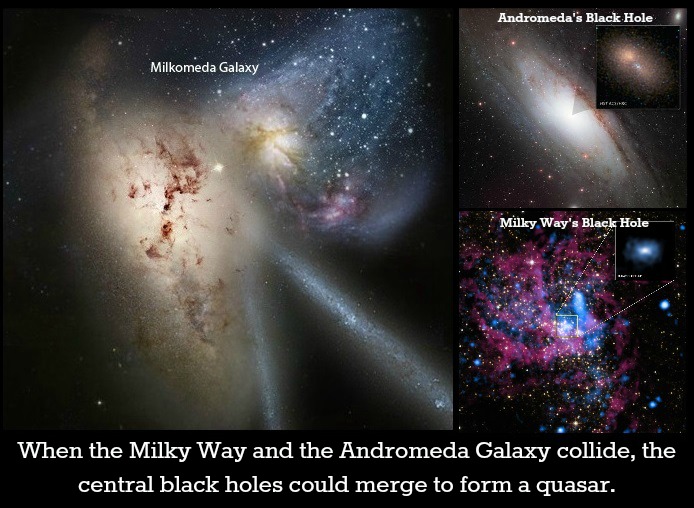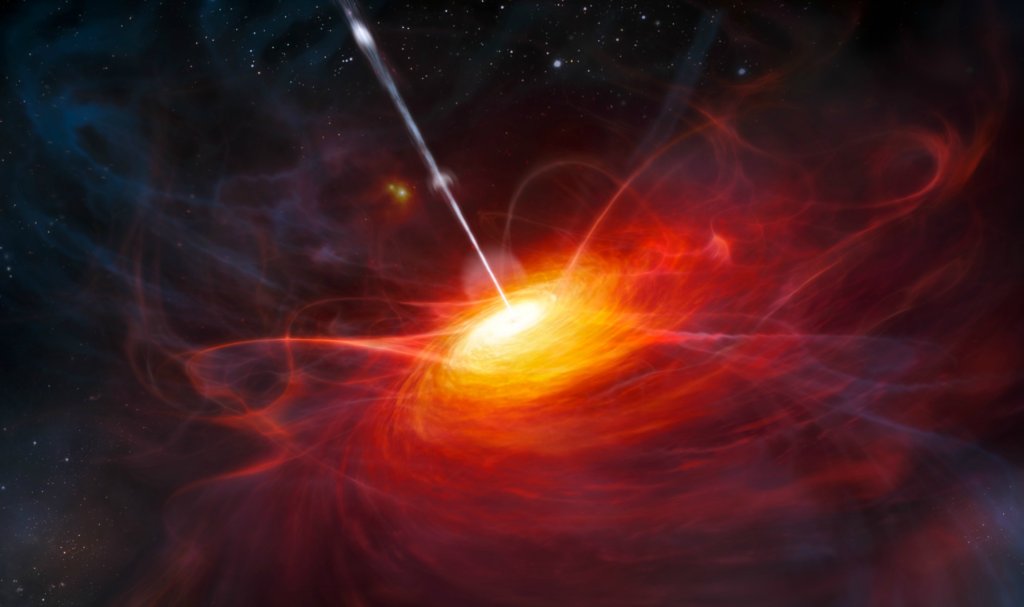

That’s pronounced “Milk-ahm-mee-da.” But, however you pronounce it, in more than 5 billion years time, our galaxy will begin to gravitationally interact with the Andromeda galaxy, the Milky Way’s closest large neighbor. As gravity starts drawing these two heavy-weights together, they will begin to collide, until all of the stars, planets and stellar materials will merge together, forming a large, elliptical galaxy.
*cue doomsday naysayers* .. or not.
One would think such an event would be cataclysmic, when in reality, it’s unlikely that any stars or planets from either galaxy will actually collide during the encounter (not that it matters too much to us regardless. Our Sun will effectively be dead – possibly having ate our planet – and anything still unlucky enough to be on it – whole). However, many questions remain about the event itself and the aftermath. One of the many lingering questions relates to the fate of the two supermassive black holes found in the galactic center of both galaxies. If both converge, like our models suggest they will, could the combined super supermassive black hole make way for a quasar? Maybe. But first:
WHAT IS A QUASAR:
Quasars are some of the oldest, most distant objects found anywhere in space (they are certainly cool enough to warrant an addition to our name!) Their age and distance are eclipsed by one thing: the sheer amount of energy they are known to produce. In some cases, quasars can emit almost 100 times more energy of all of the stars in the Milky Way combined. However, their formation is still a bit of a mystery. Astronomers work under the assumption that they form around the supermassive black hole of young galaxies. Only, for one to form, the galaxy must contain quite a bit of raw materials for star formation, like gas and dust. This essentially means that quasars generally do not form in older galaxies with negligible material.Otherwise, black holes do not have the fuel to power a quasar.

With that said, If the area has more material than the black hole can consume, some of that matter piles up and creates an accretion disk. These disks generally spin very quickly, picking up friction through gravitational stresses that will eventually result in the material becoming extremely hot and very luminous, spitting out x-rays, gamma-rays and radio waves. To this effect, all quasars are black holes, but not all black holes are quasars.
TO BE, OR NOT TO BE:
Now that we’ve discussed what a quasar is, let’s look at the specifics of our galaxy and the Andromeda galaxy. First, the black hole contained within the heart of our galaxy, known as Sagittarius A*, contains the mass of 3 million suns. While Andromeda’s central black hole contains the combined mass of one hundred MILLION suns. At the moment, our black hole is dormant, meaning it is not actively consuming any matter. After the collision is well underway, perhaps hundreds of millions of years after the initial interaction, both black holes will come within one light-year of one another, before unleashing a fury of gravitational waves and merging.

Throughout this process, depending on how much material both central regions contain (and we’re really not sure exactly how much both have or where it will be distributed), it’s quite likely that matter COULD build up more quickly than the new ultra-massive black hole can consume it, generating an accretion disk that can form an active quasar. BUT, a full-blown quasar is likely out of the cards. You see, both galaxies are quite old, thus, they already wasted away most of the material they once had. Since material is key and almost all of the quasars we’ve seen belong to very young, active galaxies, I’m going with a firm “no.” (“No,” as in, “nobody really knows.”)
Since we’re not dealing with absolutes, it must be said that even if a full-blown quasar is not in store for the new elliptical galaxy, a micro-quasar could be created. ‘Baby quasars’ form when a stellarmass black holes (this type tend to be much smaller than supermassive ones) siphon material from a near-by companion star, but they generally calm down and cool over the course of a few million years (they are definitely far less luminous and energetic). So far, we’ve actually found about four such micro-quasars in our galaxy and SEVERAL of them in the Andromeda galaxy, so alien astronomers may still have something to marvel at once the dust is settled (literally speaking)!